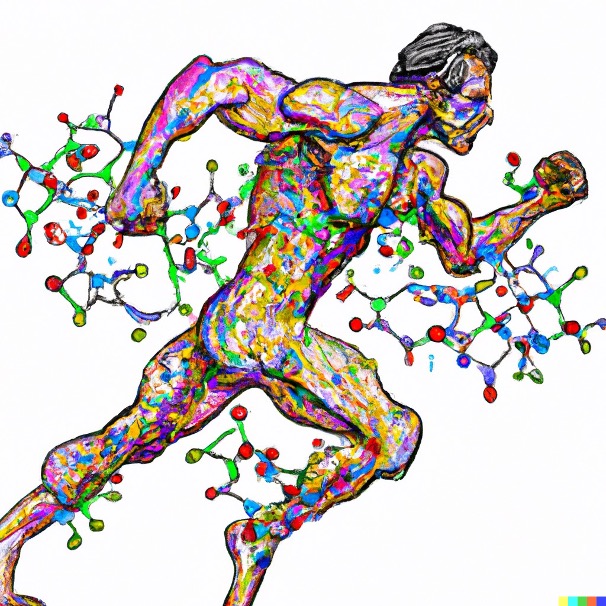
DALL-E Image: This image was created using OpenAI’s DALL-E neural network. Prompt: “Testosterone molecule in the shape of an elderly running male Olympic athlete in the style of Umberto Boccioni”
Ever hear of “andropause”?
It’s like menopause—but for men (with some important distinctions between the two).
Andropause is the result of low testosterone, one of the most underdiagnosed conditions in men.
You likely already know that testosterone is the hormone that regulates sex drive, muscle mass, and fat distribution.
But you might not be aware that testosterone progressively (and rapidly) declines as you age.
According to endocrinologist Dr. Vinita Tandon, “Every man goes through andropause, but few understand its role in the health, happiness, and performance of millions of men.” (Full disclosure: Dr. Tandon serves as Medical Director at Lifeforce, a company I co-founded.)
The main thing you should understand is that you can proactively manage your testosterone levels.
In this blog, I’ll discuss the latest research on andropause and how it can affect you, how to measure your testosterone, and strategies for safe and effective hormone optimization.
Let's dive in!
WHAT HAPPENS WHEN TESTOSTERONE LEVELS DROP?
Starting in your mid-30s, testosterone declines about 1% to 2% each year.
By the time you reach your 40s, your testosterone can be 40% lower than it was 20 years ago. Each decade of lowered testosterone can result in a 5% to 8% decline in muscle mass, accelerated bone loss, and declines in energy and physical performance.
Dr. Tandon reports that this is also when men often start to experience "I’m getting old” symptoms like:
-
More belly fat
-
A harder time maintaining muscle
-
Rising blood pressure
-
Declining bone density
-
Decreased sleep quality
-
Higher cholesterol
-
Lower sexual appetite
-
Reduced energy levels
-
Slower cognition
After the age of 50, testosterone levels can drop up to 50% from their peak, coinciding with men reporting their lowest levels of general life satisfaction (think: stereotypical midlife crisis).
Even more concerning is that we’re seeing testosterone levels decline even faster from one generation to the next.
Why?
It could be due to exposure to plastics, pollution, estrogens in the food and water supply, or other factors. “If we were to use similar data today, a man in his 30s might have similar testosterone levels to what his father had in his 50s or 60s,” says Dr. Tandon.
LEVEL CHECK: TEST YOUR TESTOSTERONE
Low testosterone is a condition that affects millions of men and yet it’s one of the most underdiagnosed.
A 2019 epidemiological study looked at the testosterone levels of 1,222 men aged 40 to 70 with a variety of male aging symptoms, and found that 55% of them had low levels.
The best way to measure your testosterone is with a comprehensive blood test on a quarterly basis. (I personally use the Lifeforce Diagnostic, which measures 40+ biomarkers including hormone balance, critical nutrients, and metabolic health.)
In general, men function at their best with testosterone levels between 600 and 900 and really start to struggle below 300, says Dr. Tandon. But every man is different and, as with many biomarkers, what constitutes a “normal” range in traditional medicine to diagnose disease isn’t what we use to optimize everyday performance.
In addition to natural decline, it’s important to also take into account lifestyle factors that could suppress your testosterone levels, such as:
-
Chronic stress
-
Obesity
-
Poor sleep
-
Recreational drugs, alcohol, and antidepressants
-
Prior concussions or brain trauma, even many years after the event
YOU *CAN* OPTIMIZE YOUR TESTOSTERONE LEVELS
Let’s say you discover that your testosterone levels are in decline. You now need to figure out how to slow or even reverse this trend.
The good news is that there are well-established and clinically-validated testosterone replacement strategies available to men today. Testosterone replacement therapy (TRT) is a safe and effective technology that an increasing number of men are using to live full and demanding lives in their 40s, 50s, and 60s.
The Journal of Clinical Investigation published a study last year showing that the most common benefits of TRT are:
-
Improved sexual function
-
Increased muscle mass, strength, and mobility
-
Reduced fat mass, including visceral fat
-
Modestly better aerobic capacity
-
Improved depressive symptoms
Hormone optimization is an effective way to get you back to your best zones, but it needs to be done right.
3 WAYS TO SAFELY BOOST YOUR TESTOSTERONE
The goal of testosterone optimization isn’t to gain “super-physiological" levels of testosterone—it’s to find and maintain the range that works best for you.
Endocrinologist Dr. Tandon offers a few approaches to do that, along with considerations for each one:
1. Exogenous Testosterone
This is what most people commonly think of as TRT.
The dosage is either a daily cream or weekly injection of bioidentical synthetic testosterone that can raise levels by 50% or more in 2 to 4 weeks. It’s the most reliable and fastest way to get results but it often leads to decreased natural testosterone production, which can affect fertility.
What to consider: Exogenous testosterone is expensive, and the cream must be carefully managed to avoid accidental transference to other people through skin contact. Additional pharmaceuticals may also be needed to maintain balance and mitigate side effects, such as anastrozole to block estrogen conversion, or clomiphene to improve natural testosterone production. You’ll want to consult with your personal physician to determine what is best for you.
2. Testosterone Boosting Supplements
If you need only a small boost of testosterone or you’re reluctant to start exogenous testosterone, over-the-counter supplements might be right for you.
Zinc, ashwagandha, vitamin D, and magnesium are some supplements that can help the body naturally process testosterone with minimal side effects. You might see an improvement of 0 to 50 ng/dl in 1 to 2 months.
What to consider: Results can be modest and unreliable.
3. Lifestyle Changes
Reducing body fat, getting adequate sleep, managing stress, and avoiding drugs and alcohol can positively impact testosterone levels. Lifestyle changes can improve your levels by 100 to 200 ng/dl in 3 to 6 months.
What to consider: Making these changes will also amplify the effects of both exogenous testosterone and testosterone supplements while lowering your risk of other health conditions. But motivation and follow-through can be tough if you are already suffering from low testosterone.
(If interested, you can learn more about hormone optimization & Lifeforce membership here.)
ARE YOU READY TO GO FROM SUCCESS TO SIGNIFICANCE?
Then consider joining my year-round Abundance360 Mastermind and Executive program and participate in our A360 Summit March 20-22, 2023.
Topics: Entrepreneurship Longevity andropause







